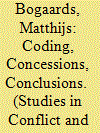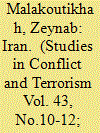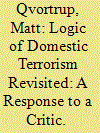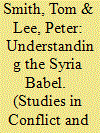|
|
|
Sort Order |
|
|
|
Items / Page
|
|
|
|
|
|
|
| Srl | Item |
| 1 |
ID:
175584


|
|
|
|
|
| Summary/Abstract |
In the past nine years, three lone wolf terrorists have targeted military bases or recruiting centers in the United States and research suggests attacks on the U.S. military are increasing globally. The problem was that research had not addressed the lived experiences of survivors of lone wolf attacks, nor how they could inform procedures regarding a sense of security for military men and women. The purpose of this research was to establish a need to address threats to the security of the military from these attacks, to provide a rich description of survivors’ experiences of the attack at Fort Hood, and to identify suggestions for improving military personnel’s sense of security while on base. Using the community-based approach to public health. the central research question asked how the lived experiences of survivors of the attack at Fort Hood could lead to an increased sense of security on base. The study revealed high levels of stress, hyperawareness, and negative changes in the lives of these soldiers. The findings suggest an increased show of force by police throughout the base, a designated office for anonymously reporting suspicious activity, and more training to help soldiers cope with the experiences of combat-related trauma.
|
|
|
|
|
|
|
|
|
|
|
|
|
|
|
|
| 2 |
ID:
175586


|
|
|
|
|
| Summary/Abstract |
In August 2011, international recruitment to terrorist groups became a growing concern for the United States. The Obama administration started a public–private partnership pilot program focused on countering violent extremism (CVE) in the United States. This program was the first of its kind. It directly addressed the administration’s concern about domestic violent extremism and radicalization in the United States. The Twin Cities’ program, Building Community Resilience, focused primarily on prevention of radicalization through a community and government partnership. This article analyzes tensions between government-sanctioned CVE approaches and the communities where programs are implemented. Until now, research and analysis have not been performed on this specific program from a community perspective.
|
|
|
|
|
|
|
|
|
|
|
|
|
|
|
|
| 3 |
ID:
175581


|
|
|
| 4 |
ID:
175587


|
|
|
|
|
| Summary/Abstract |
Why do extremist organizations issue terrorist bluffs? According to previous research, empty threats against civilians are likely to negatively influence assessments of groups’ strength and credibility, thus making it more difficult for extremists to achieve their goals. Despite these potential audience costs, bluffing is a common terrorist tactic. This inquiry assesses data on the bluffing patterns of three organizations—Boko Haram, Jamaat-ul-Ahrar, and the Real Irish Republican Army—and finds that groups suffer few costs for making empty terrorist threats. Furthermore, extremists bluff to advance a variety of strategic goals including outbidding rival factions, spoiling peace settlements, and intimidating civilians.
|
|
|
|
|
|
|
|
|
|
|
|
|
|
|
|
| 5 |
ID:
175589


|
|
|
|
|
| Summary/Abstract |
The proliferation of jihadist groups raises intriguing questions about their internal relationship. Drawing on Resource Mobilization Theory we explore this question by examining the relationship between the Taliban and the local incarnations of the Islamic State of Iraq and Syrian (ISIS) in Afghanistan. We conceive the Taliban and ISIS as parts of a broader “jihadist movement industry” that is simultaneously united and divided by the logic of their embeddedness in the movement. While most existing research emphasizes intra-jihadist conflict or rivalry, we found that the relationship between the two groups goes through cyclical shifts, vacillating between conflict and cooperation.
|
|
|
|
|
|
|
|
|
|
|
|
|
|
|
|
| 6 |
ID:
175582


|
|
|
|
|
| Summary/Abstract |
Iran has a longstanding connection with terrorism, in particular after the 1979 Islamic Revolution. It has been recognized as both a victim and state sponsor of terrorism, but has predominantly been accused of supporting terrorism worldwide. Iran has been accused of training, financing, and providing weapons and safe havens for nonstate militant actors, such as Hezbollah and Hamas. While Iran considers such groups as national liberation movements, they are by contrast designated as terrorist groups according to other countries. At the same time, Iran has suffered from terrorist attacks, although Iranian security has proven much superior to its neighbors, such as Iraq, Syria, and Afghanistan. Regardless of claims relating to Iran as a victim or sponsor of terrorism, no official policy or document has been published by the government by way of a counterterrorism policy because any stated policy would be subject to accountability, human rights, and the rule of law. In practice, its focus is placed on the “War by Terror” as an external instrument as opposed to internal “Counterterrorism.” By analysis of official documents, statements, and laws, both Persian and English sources, this article aims to clarify Iran’s counterterrorism policy and framework and the actual practices of Iran in the Middle East.
|
|
|
|
|
|
|
|
|
|
|
|
|
|
|
|
| 7 |
ID:
175579


|
|
|
|
|
| Summary/Abstract |
Can inclusive institutions tame the threat of domestic terrorism? In a series of recent publications, the political scientists Arend Lijphart and Matt Qvortrup claim that consensus democracies are not only kinder and gentler, but also safer: consensus democracies are less likely to experience deadly domestic terrorism and when they do, they suffer fewer fatalities than majoritarian democracies. This article reexamines the logic and the evidence. It argues that the underlying grievance theory of terrorism contains important gaps and that the statistical results are based on a problematic coding of cases and lack robustness. Lijphart and Qvortrup have opened up an important new line of inquiry, but their results do not withstand scrutiny.
|
|
|
|
|
|
|
|
|
|
|
|
|
|
|
|
| 8 |
ID:
175580


|
|
|
|
|
| Summary/Abstract |
The article responds to criticisms raised by Matthijs Bogaards. While he makes a number of valid methodological points, it is maintained that the Qvortrup–Lijphart Model of Domestic Terrorism remains paradigmatic. Part of the criticism seems to be based on a misunderstanding of the requirement that causal theories should be as parsimonious as possible. Further, Bogaards does not provide an alternative that both accounts for the occurrences explained by the model as well as the issues that were explained by it (as is required by falsificationist methodological rules). In short, the theory that institutions can contribute to limiting the occurrence of domestic terrorism remains strong, at least in developed capitalist societies. There is no viable alternative; opportunities for democratic engagement are a potent force against political violence.
|
|
|
|
|
|
|
|
|
|
|
|
|
|
|
|
| 9 |
ID:
175583


|
|
|
|
|
| Summary/Abstract |
Why would individuals engage in or support contentious politics? This question is challenging to answer with observational data where causal factors are correlated and difficult to measure. Using a survey-embedded experiment, we focus on three situational factors: grievances, risk, and identity. We also explore how individual differences in sociopolitical orientations—social dominance orientation (SDO) and right-wing authoritarianism (RWA)—impact action. Grievances influence engagement in and support for protests. Risk influences engagement in protest, but not support for it. Regardless of condition, SDO and RWA help explain why some people engage in protest while others do not, particularly within the same context.
|
|
|
|
|
|
|
|
|
|
|
|
|
|
|
|
| 10 |
ID:
175578


|
|
|
|
|
| Summary/Abstract |
In this article, we present the findings of the first systematic scoping review of scientific literature on radicalization into violent extremism since the Al Qaeda attacks on 11 September 2001. We selected and categorized all scholarly, peer-reviewed, English-language articles published between 2001 and 2015 that empirically investigated the factors of radicalization into violent extremism (N = 148). In the analysis we consider two main dependent variables (behavioral and cognitive radicalization) and three main independent variables (push, pull, and personal factors). “Pull” factors of radicalization emerge as the main factors of radicalization across studies focused on different geographical areas and ideologies. This article points to the need to focus more on the interaction between push, pull, and personal factors, and to diversify the methodologies used in the field.
|
|
|
|
|
|
|
|
|
|
|
|
|
|
|
|
| 11 |
ID:
175588


|
|
|
|
|
| Summary/Abstract |
One recurring theme of the immediate post-9/11 environment was that of regional political organizations and violent lone-wolf actors pledging allegiance to Osama bin Laden’s Al Qaeda group (AQ). Following the Islamic State of Iraq and Syria (ISIS)’s 2014 capture of Mosul, Iraq, many of these loose affiliations began shifting to ISIS. This resulted in a blurring of distinctions between different types of Sunni jihadi organizations, with media commentators and analysts at times referring to groups as “Al Qaeda–like” or “ISIS-affiliated,” despite those groups’ goals and operational scopes being largely disconnected from both AQ and ISIS. This article proposes a new typology of Sunni jihadi groups according to theater of operation, strategy, and geopolitical alignment. This typology offers three categories: global jihad, local jihad, and sectarian jihad. In addition, it identifies four types of operation types that Sunni jihadi groups adopt: (1) core theater attacks, (2) power-projection attacks, (3) local recruitment, and (4) foreign recruitment. The main contribution of this article is its frameworks for improving the quality of the analysis of Sunni jihadi groups.
|
|
|
|
|
|
|
|
|
|
|
|
|
|
|
|
| 12 |
ID:
175590


|
|
|
|
|
| Summary/Abstract |
The war in Syria, and its ongoing analysis, is burdened by a variety of seemingly irreconcilable political motivations, actions, ideologies, religious affiliations, and power dynamics of multiple state and nonstate actors. In this context, various moral perspectives appear to come into direct conflict, underpinning the actions of the actors involved and to varying degrees influencing their competing political interests. Is there a coherent dialogue of moralities between the rivals involved or is Babel reborn with moral claims being launched but with no real exchange of meaning involved? On Syria, the answer is a complicated mixture of both but within which are important and as yet underappreciated patterns of convergence and divergence. This article looks at the leading states involved as well as the role of individuals to elucidate this pattern of overlap and difference in the morality discourses surrounding Syria. Ultimately, it is argued that a moral Babel is not reborn in Syria: there is sufficiently common moral language being used by all sides for a degree of shared meaning to emerge. The challenge is for the protagonists to listen and really hear what is being said and work with those commonalties as tools toward peace.
|
|
|
|
|
|
|
|
|
|
|
|
|
|
|
|
| 13 |
ID:
175585


|
|
|
|
|
| Summary/Abstract |
Since the Syrian Civil War broke out in 2011, there has been an unprecedented mobilization of Iran-backed Shi’a foreign fighters to Syria to protect Shi’a communities and shrines, combat the Islamic State, and buttress Syrian President Bashar al-Assad. As the conflict nears a resolution, the fate of these Shi’a fighters remains uncertain. This article argues large numbers of Shi’a foreign fighters will engage in domestic and transnational insurgency and civil war due to hardening sectarian identities, a nascent pan-Shi’a ideology, Iranian direction, and the presence on ongoing conflicts in the Middle East and South Asia; however, the threat is lessened by so-called off-ramps, ranging from death to disillusionment with conflict. The article concludes with implications and policy recommendations for U.S. leaders.
|
|
|
|
|
|
|
|
|
|
|
|
|
|
|
|
| 14 |
ID:
175577


|
|
|
|
|
| Summary/Abstract |
Why are female migrants rarely attacked in “Sons of the Soil” (SoS) violence? Based on interviews with key stakeholders in Indonesia and China, we argue that women are shielded from the brunt of migration-related violence due to gendered patterns of migration and economic integration that highlights the positive contributions of female migration to the host region while drawing attention to the threat posed by male migration. By bringing together the literature on migration, gender, inequalities, and conflict, this article makes a foray into the previously unexamined dynamics affecting victimization patterns in armed conflict in general and SoS conflict in particular.
|
|
|
|
|
|
|
|
|
|
|
|
|
|
|
|
|
|
|
|
|